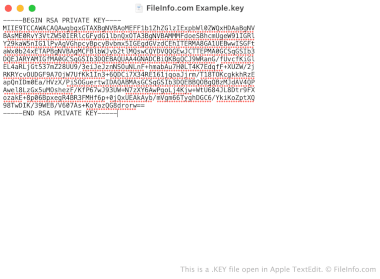.KEY File Extension
Software License Key File
| Developer | N/A |
| Popularity |
3.7 | 826 Votes |
What is a KEY file?
A KEY file contains a license key an application references to register itself to a computer on which it is installed. It may save the key in a plain text format but typically stores an encrypted key string that authenticates the purchase and registers the software. The .key file extension is a generic file extension for software license keys used by various programs to register legal copies of the software.
More Information
Typically, the software developer distributes a KEY file to a user after they purchase the software to register an application offline. The user may then need to place the file in a specific directory or open it with the application to register the software.
NOTE: Windows applications primarily use KEY files, but programs on other operating systems may also use the files.
How to open a KEY file
You can open a KEY file with the application the key is created to register. However, since the .key file extension is generic and used by various software products, you need to know which program the KEY file corresponds with to register the software.
Programs that open KEY files
LightWave 3D License File (Legacy)
| Developer | NewTek |
| Popularity |
3.4 | 275 Votes |
A KEY file may also be a software registration file used by NewTek LightWave 3D, a professional 3D rendering application. It stores a 16-digit license key, enabling users to activate a legal copy of the software. NewTek replaced KEY files with .LWK files when it released version 11 of LightWave 3D.
More Information
LightWave 3D is a computer graphics application that renders static and animated 3D images. Professionals use the software in various fields, including television, film, video game development, building visualizations, and product design.
You will only encounter a software registration KEY file when purchasing and activating LightWave 3D (before version 11). For example, after purchasing LightWave 3D online, NewTek displays instructions to download LightWave 3D and provides a license.key file to register the application to your computer.
However, since NewTek replaced KEY files with LWK files, LightWave 3D now uses LWK files. Therefore, to register the trial version of LightWave 3D (11.0.3 or later), place the LICENSE.LWK file in the "licenses" folder in the LightWave installation directory to register the software.
Common KEY Filenames
license.key - Name of the KEY file sent to users who have purchased LightWave 3D,
How to open a KEY file
KEY files are not meant to be opened. Instead, you can place the KEY file in the "licenses" folder in the LightWave 3D installation directory to register the software.
For example, to register LightWave 3D 10, place the KEY file in the following directory:
- Windows - [user]\.NewTek\LightWave\10.0\licenses\
- Mac OS X - [user]/Library/Application Support/NewTek/LightWave/10.0/licenses/
Although KEY files are not meant to be opened, you can open them with a plain text editor to view the license key.
Programs that open or reference KEY files
Apple Keynote Presentation
| Developer | Apple |
| Popularity |
3.6 | 112 Votes |
A KEY file may also be a presentation created by Apple Keynote, a macOS and iOS presentation application. It contains slides that may include text, images, shapes, charts, tables, transitions, audio, video, and notes. KEY files may save various types of presentations, including financial proposals, research findings, and book report summaries.
More Information
Keynote is one of Apple's three productivity apps that make up iWork, along with Pages and Numbers. These applications are Apple's versions of the more popular PowerPoint, Word, and Excel programs, which are developed by Microsoft and available in the Office suite. The iWork apps are developed for macOS and iOS but can also be accessed using a browser on a Mac or PC through iCloud.
KEY files are generally used for storing presentations for academic, business, or personal purposes that Keynote can display. For example, you can create a KEY file to save a presentation filled with photos from your summer vacation, tables and charts of data detailing a business proposal, book report information for a class, and more.
Keynote comes with many templates to get you a jumpstart on your presentation, or you can start from scratch with blank slides. Then, when you finish creating your presentation, you can share it directly from your device or through Keynote Live to stream the presentation online.
How to create a KEY file
To create a KEY file with Keynote, select File → Save in the application. Keynote then creates a KEY file and saves your presentation's contents in the file. After saving the presentation, you can close it and reopen it later for further editing.
How to open a KEY file
In macOS and iOS, you can open KEY files with Apple Keynote. To open a KEY file with Keynote on a Mac, select File → Open... in Keynote. If you are looking to only view the KEY presentation, you can open it with Apple Preview, and each slide is presented as a static image.
You can also upload KEY files to the iCloud version of Keynote in your web browser (requires an Apple ID). This is helpful for Windows users who don't have access to the Mac or iOS versions of Keynote. In the iCloud application, you can view, edit, save, and download KEY presentations.
How do I open KEY files in Windows and Linux without an Apple ID?
Windows and Linux users who do not have an Apple ID can open KEY files with LibreOffice Impress. However, Impress users should be aware that the program often alters KEY files' original formatting. Impress also does not allow users to save presentations as KEY files. Therefore, if you make any changes to a KEY file in Impress, you must save the edited file as an .ODP or PPTX file.
How to convert a KEY file
Apple Keynote can convert KEY files to several different formats. In the macOS version, select File → Export To, then choose one of the following formats:
- .PPTX / .PPT PowerPoint presentation
- .PDF document
- .MOV or .M4V video
- .JPEG image
- .PNG image
- .TIFF image
- .HTML webpage
- Animated .GIF
- Keynote '09 presentation
You can also convert KEY files to PDF files with Apple Preview by selecting File → Export as PDF....
Programs that open KEY files
Keyboard Definition File
| Developer | N/A |
| Popularity |
3.3 | 46 Votes |
A KEY file contains information that defines the layout of a keyboard. It includes information that maps keys to different characters and may also store custom keyboard shortcuts. KEY files may be custom-made by a user or come with an operating system.
More Information
KEY files store variations of keyboards, whether it be because of different languages with unique characters or keyboard shortcuts for gamers and video editors. For example, a KEY file that stores an English keyboard layout may be named EN.key, and a KEY file that stores a Spanish keyboard layout may be named SP.key.
If the KEY file comes with an operating system, you will most likely be able to find it with the other system files. If you create a KEY file with a program, the application most likely saves the KEY file in the program installation directory.
How to open a KEY file
Typically, the program or operating system that supports the KEY file references the file to map keys typed by a user to the appropriate function. If this is the case, the KEY file is not meant to be opened.
However, the KEY file may be saved in plain text, which means you may be able to open and modify it with a plain text editor. You can try opening a KEY file with a text editor to verify if this is the case. To do this, you may need to change the .KEY file extension to .txt before attempting to open it with a text editor, such as Microsoft Notepad or Apple TextEdit.
Programs that open or reference KEY files
Privacy-Enhanced Mail Private Key
| Developer | N/A |
| Popularity |
4.3 | 3 Votes |
A KEY file may also be a private key saved in the Privacy-Enhanced Mail (PEM) key format. It contains a string of text that is used to decrypt information sent from a web browser to a web server. KEY files are typically generated automatically as part of installing an SSL certificate on a web server.
More Information
To certify that users' information is being handled securely, web server owners must apply for and install an SSL certificate. (These certificates may also be referred to as X.509 certificates.) Installing the certificate generates a public key, which is used to encrypt users' information as it is sent from their web browser to the web server, and a private key, which is used to decrypt the information when it reaches the web server.
In some cases, SSL certificate private keys are saved as KEY files. KEY files are generated using the PEM key format, which uses Base64 encoding to translate binary code into a text string. As a result, KEY files are text files that look something like the text below:
-----BEGIN RSA PRIVATE KEY-----
[RSA private key text]
-----END RSA PRIVATE KEY-----
NOTE: PEM private keys are more often saved with the .PEM extension. You are most likely to find KEY files on Linux-based systems after generating a key using OpenSSL. KEY files are often stored in the usr/local/ssl directory.
How to open a KEY file
Because KEY files are plain text files, you can open them in any text editor, such as Microsoft Notepad (Windows), Apple TextEdit (Mac), or GitHub Atom (cross-platform). However, you should not edit the text your KEY file contains. Editing your KEY file will cause your web server or website to function incorrectly.
For instructions on how to use your KEY file with a web server as part of an SSL certificate, refer to your web server or certificate's documentation.
Programs that open or reference KEY files
Android Passcode File
| Developer | |
| Popularity |
2.8 | 12 Votes |
A KEY file may also be a passcode file used by an Android device. It stores the passcode, password, or gesture pattern used to unlock the device. KEY files are stored in a device's data/system folder.
More Information
When a user attempts to unlock their Android device, the device checks the entered passcode, password, or unlock gesture against the data stored in the device's KEY file(s). Most users will never encounter or have to open their Android KEY files. However, forensic analysts who want to access a locked Android device sometimes use KEY files to determine the device's passcode, password, or unlock gesture.
Common KEY Filenames
password.key - Contains an Android device's passcode or password.
gesture.key - Contains an Android device's unlock gesture.
How to open a KEY file
KEY files are not meant to be opened. However, some forensic analyst software, such as GestureCrack, allows users to extract the unlock credentials a KEY file contains.

